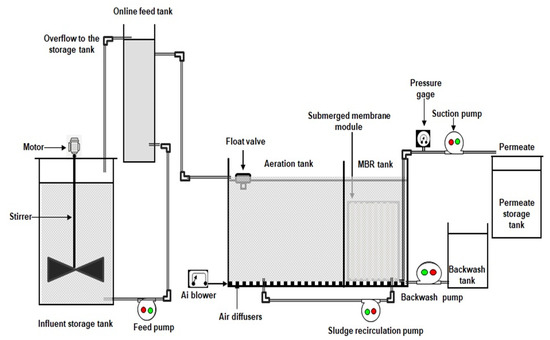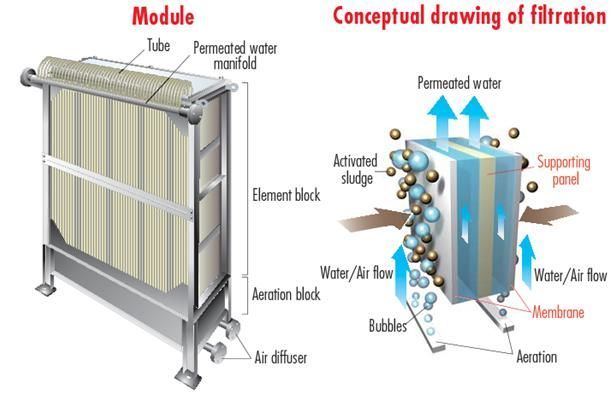Innovations in Membrane Bioreactor Technology for Enhanced Environmental Sustainability
Innovations in Membrane Bioreactor Technology for Enhanced Environmental Sustainability
Blog Article
Just How Membrane Bioreactors Are Changing Water Purification Equipments
The development of membrane layer bioreactors (MBRs) stands for a significant improvement in the field of water filtration, merging organic therapy processes with sophisticated membrane purification innovations. This integration not just boosts the quality of treated effluent yet likewise addresses city space restrictions, making MBRs particularly ideal for densely inhabited locations. As worldwide water deficiency heightens, the function of MBRs in helping with drinkable water reuse and lasting water management ends up being significantly crucial. The ramifications of this modern technology expand past effectiveness-- what obstacles and possibilities exist in advance for its extensive execution?
Introduction of Membrane Layer Bioreactors
Membrane layer bioreactors (MBRs) represent a significant advancement in water filtration modern technology, as they integrate biological treatment procedures with membrane layer filtering. This integration boosts the performance of wastewater treatment by using bacteria to degrade organic toxins while at the same time utilizing semi-permeable membrane layers to different cured water from put on hold solids and virus.
The MBR system commonly is composed of a biological activator where the microbial population metabolizes pollutants, followed by a membrane layer filtering device that maintains biomass and allows just clean water to travel through. This double functionality leads to higher effluent quality contrasted to traditional treatment techniques. MBRs can be operated in both batch and continual circulation settings, using flexibility in style and application.
They additionally make it possible for the recuperation of water for reuse, therefore adding to water sustainability efforts. In general, MBRs are at the leading edge of boosting water treatment performance and top quality, showcasing the capacity for cutting-edge remedies in environmental management.
Benefits of MBR Modern Technology
The combination of organic therapy with membrane layer purification offers many benefits for water filtration procedures. Among the primary benefits of Membrane Bioreactor (MBR) modern technology is its capacity to effectively get rid of both not natural and organic pollutants, leading to premium effluent. The membranes function as a physical barrier, protecting against put on hold solids and virus from travelling through, which enhances the overall security and integrity of cured water.
Furthermore, MBR systems need a smaller sized impact compared to standard therapy techniques, permitting more reliable room usage. This small design is particularly useful in urban settings where land is restricted. MBRs additionally show operational versatility, fitting differing influent qualities and flow prices without considerable efficiency deterioration.
Additionally, the process uses improved nutrient removal capacities, specifically for nitrogen and phosphorus, which are essential for avoiding eutrophication in receiving waters. The lowered sludge manufacturing related to MBR modern technology likewise translates to decrease disposal costs, making it an affordable service over time - Membrane Bioreactor. In general, the benefits of MBR modern technology placement it as a leading selection for cutting-edge and lasting water filtration systems, addressing both environmental and economic worries
Applications in Water Purification
Applications of Membrane Layer Bioreactor (MBR) innovation in water purification are impactful and diverse, dealing with different treatment needs throughout several industries. MBRs properly combine organic treatment procedures with membrane layer filtration, making them excellent for community wastewater treatment, industrial effluent administration, and also potable water reuse efforts.
In local setups, MBRs are increasingly employed to enhance the quality of treated wastewater, enabling compliance with stringent discharge policies and assisting in the recycling of water for watering and non-potable uses. Their small style likewise makes them suitable for urban environments where space is limited.
Industrially, MBR technology is utilized to deal with process water and wastewater, especially in industries such as food and beverage, pharmaceuticals, and textiles. By effectively removing pollutants and suspended solids, MBRs assist industries minimize environmental impacts while recuperating useful resources from wastewater streams.
Furthermore, MBRs are gaining traction in additional resources decentralized water therapy applications, where small systems can be released in remote locations or establishing regions. This adaptability makes it possible for areas to accomplish lasting water management remedies, boosting access to tidy water while decreasing dependence on standard therapy methods.
Case Studies and Success Stories

In another example, a fabric manufacturing center in Bangladesh adopted MBR modern technology to resolve its wastewater obstacles. The system decreased chemical oxygen need (COD) levels from 1,200 mg/L to much less than 100 mg/L, thus fulfilling regulative criteria and substantially reducing ecological impact.
The College of Cape Community's MBR setup has actually verified effective in dealing with greywater for non-potable reuse on school. This project not just conserves drinkable water however also acts as an educational design for lasting practices.
Moreover, a fish and shellfish processing plant in Norway made use of MBR technology to deal with effluents having high levels of raw material, achieving over 90% contaminant removal. These case researches emphasize MBR innovation's adaptability and its essential duty in enhancing water quality across diverse applications.
Future of Water Therapy Solutions
As global water scarcity and pollution obstacles escalate, innovative water treatment services are ending up being progressively important to make sure lasting accessibility to tidy water. The future of water treatment lies in the combination of advanced technologies that enhance the performance and efficiency of purification processes. Membrane bioreactors (MBRs) are at the forefront of this development, incorporating biological treatment with membrane filtering to generate top notch effluent appropriate for various applications.

Emerging patterns such as resource recovery from wastewater, including nutrients and energy, will certainly better transform therapy centers right into environmentally friendly centers. Moreover, developments in nanotechnology and membrane materials guarantee boosted efficiency and durability of filtration systems.

Conclusion
To conclude, membrane bioreactors represent a significant improvement in water filtration innovations, efficiently combining biological treatment with advanced membrane layer filtering. The numerous advantages, including enhanced effluent high quality and minimized spatial demands, make MBRs particularly suitable for urban applications. Their role in potable water reuse and lasting water management highlights their importance in attending to international water scarcity challenges. Proceeded r & d will additionally improve the efficiency and adoption of MBR modern technology, making certain a durable future for water therapy solutions.
The emergence of membrane bioreactors (MBRs) stands for a substantial improvement in the field of water filtration, combining biological treatment processes with advanced membrane layer purification innovations. As global water shortage heightens, the duty of MBRs in facilitating safe and clean water reuse and lasting water monitoring becomes progressively critical. They likewise enable the recovery of water for reuse, therefore adding to water sustainability campaigns.As global water scarcity and contamination obstacles intensify, innovative water treatment services are coming to be click this site increasingly important to make sure lasting accessibility to tidy water. Their function in potable water reuse and sustainable water management highlights their importance in resolving global water deficiency obstacles.
Report this page